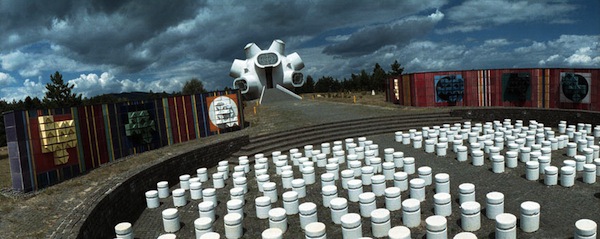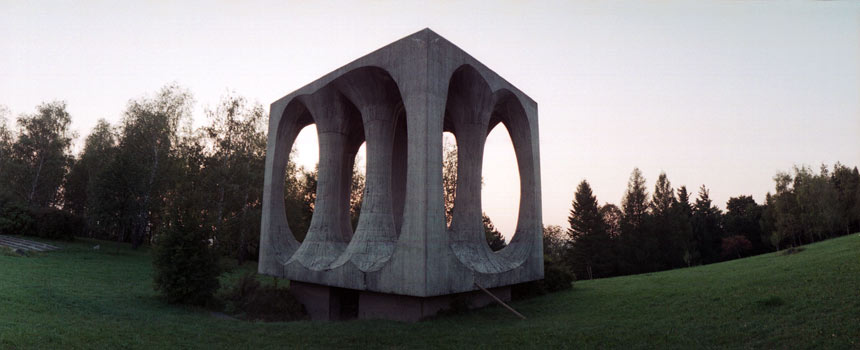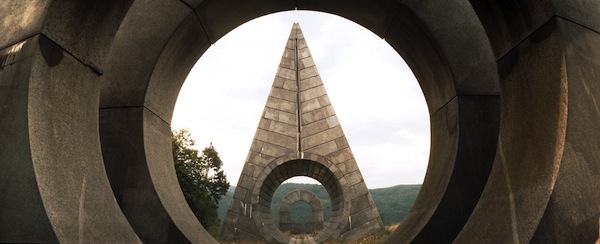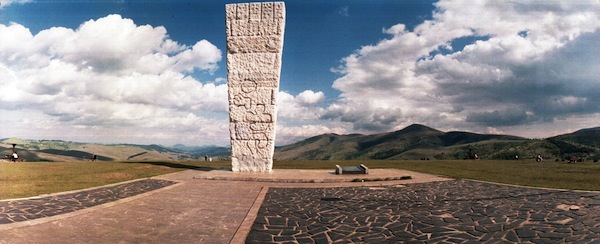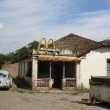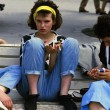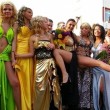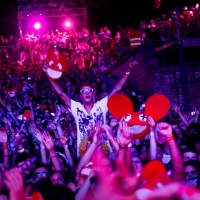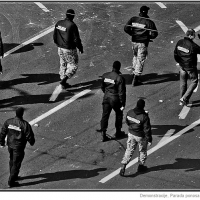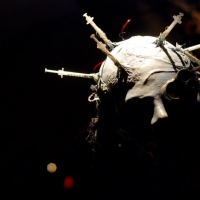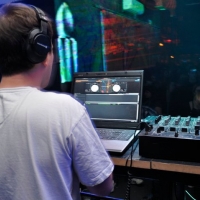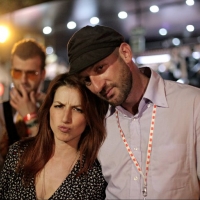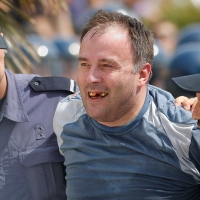The photographer known for his breathtaking pictures of abandoned Yugoslav monuments “that look like they’re from the future” speaks to Nina Bunjevac about his experiences in the Balkan lands while tracing some of world’s least known masterpieces of memorial sculpture
During my last visit to Belgrade I had a great privilege of meeting Marc Schneider, aka Marko Krojac, a German photographer, former member of the Berlin squat scene and a resident photographer aboard the MS Stubnitz. Since 2002, Marc has been dividing his time between Berlin and former Yugoslav republics, particularly Belgrade, where he acts as a band manager, photographer and a chauffeur of the local group, Klopka za Pionira.
What Marc is perhaps best known for is his photographic documentation of the WWII monuments which had been originally commissioned by the former Yugoslav president Tito between the 1940s and the 1980s. Though created by top sculptors, architects and master craftsmen, most of these monuments were erected in isolated and remote areas, marking locations where some of the crucial WWII battles took place.
Marc makes a point of going back and revisiting the same monuments over and over again; the resulting before and after shots show an interesting range in attitudes towards history in former Yugoslav republics; some show utter neglect and desecration, some show – surprisingly so – some amount of care, even renovation. Naturally, this lead Mark into an ongoing search for public art in all former Yugoslav republics, including pieces that were commissioned after disintegration of Yugoslavia by their newly formed governments. Looking at all these photographs combined, one could easily piece together a clear picture of the history of Balkan states.
You have become such an integral part of the cultural scene in Serbia that many people assume you came from these parts; you speak the language well, you understand the history of the region better than most people of Balkan origins. How did it all start? When was the first contact made?
In 2001 I was invited to Sarajevo to organize an exhibition and presentation about the MS Stubnitz; the exhibit took place in January of 2002. As soon as I arrived in Sarajevo I immediately fell in love, not only with the city and the country but also a girl. About six months before the exhibit I had left the ship and was living with some friends in a farmhouse in the north of Tuscany. In June 2002 I left Italy and embarked on a twenty day journey by boat down the Adriatic coast.
Can you imagine how wonderful that trip was? I saw the whole of Dalmatian coast, top to bottom, ending up in the gulf of Boka Kotorska in Montenegro; I thought I had found paradise, what I had always been dreaming of, the mountains and the sea, so close together. I met my girlfriend, (who was originally from Zemun) in Kotor where she owned a small house and we began travelling together – Trieste, Belgium and the Netherlands where we worked on the MS Stubnitz for a month. Our travelling eventually took us back to Sarajevo, Belgrade and then Kotor again where we decided to settle down for a while.
As I had a lot of time on my hands and hardly spoke any language, I began writing for the first time in my life; I began reading as well – about local history and culture, fiction and poetry by domestic authors like Danilo Kis, Miroslav Krleza, Mesa Selimovic, Milos Crnjanski… I am also a big fan of the younger authors like Dubravka Ugresic, Bora Cosic, Miljenko Jergovic and David Albahari. I wanted to understand my surrounding.
As I am a fan of underground music I also began to research local underground bands. Learning Serbo-Croatian was difficult for me as I am not that good at languages. While staying in Belgrade everyone who spoke to me would immediately switch to English, which made my learning of the language even more difficult. In 2006 Vladimir Lenhart, Serbian musician of Slovak origin, became my first teacher. I had no idea whether or not he spoke English, but to me he refused to do so; you could imagine my surprise when, months after our meeting I heard him speak English to a couple of Italians.
My second teacher was Mileta Mijatovic of the ex-Yugoslavian music band Klopka za Pionira, who did not speak English. We had many common interests; it was at his place that I first came across the book titled Revolutionary Sculpture. We began travelling together; during our first ten-day trip we visited and photographed about 100 monuments, in Croatia, Montenegro, Bosnia and Herzegovina and Serbia.
Every project that requires dedication and determination seems to originate from a specific moment of great inspiration; what prompted you to take on such a massive project such as your documentation of the WWII monument? Was there a particular time or place you can recall when you said: “Wow, I HAVE to photograph that!”? What was the inspiration behind this project?
The first “wow” moment happened in June 2002, when I came across the ruins of the monument on Makljen while driving through Bosnia; although destroyed, the monument looked quite impressive as I drove up the hill from Prozor. I hardly knew anything about the monuments at this point. Shortly before that I travelled to Jablanica, interested in photographing the ruins of the bridge on Neretva; little did I know that the bridge would become a monument as well. Eventually I began paying closer attention, and in 2003 visited the Sutjeska/Tjentiste monument by Miodrag Zivkovic. After reading Der Verdammte Baumeister, an autobiography by Bogdan Bogdanovic, one of the leading post WWII architects, I slowly began to understand the significance of these monuments.
In 2004 I found a copy of the Tourist Map of the Yugoslav Revolutionary Monuments in a Belgrade second-hand book shop, for which I paid 150 dinars [around $1.5]. What inspired me the most was the modernist design and wonderful composition, especially in site-specific pieces such as those created by Bogdan Bogdanovic. When you stand in these places, surrounded by wonderful nature and beautiful sculptures, you cannot help but think about the history these monuments symbolize, and its contrast to those beautiful surroundings. I soon understood just how closely connected this history is to our own, German history.
Do you have a favorite monument or a sculptor?
There are some. My absolute favorite is Bogdanovic, architect, philosopher and occultist. In 1952 he created one of the first modernist monuments at the Jewish cemetery in Belgrade. I had a privilege of meeting him in person before he died. He was such a sympathetic and positive old man – we spent five hours together, joking and laughing, and we polished off half a liter of whiskey and a bottle of wine! For the longest time it was believed that he never used socialistic symbols in his work.
Last year I finally made my way to Berane in order to photograph my 20th and final monument by Bogdanovic; I must say I was a bit anxious, but like all of his monuments it was fantastic. To my greatest surprise, I found a hammer and a sickle, even a few stars – all made in that distinct Bogdanovic style!
Truth be told, it is hard to separate my absolute favorite monuments, there are so many beautiful ones; I love most of the monuments created by Miodrag Zivkovic, although his work has changed after the war of the 90s – he is now known for creating sculptures of Serbian heroes and crucifixes.
My favorite monument is Petrova Gora, by the sculptor Vojin Bakic. It’s an impressive eight-storey, 37m high building, wrapped in stainless steel. Sadly, in the last year or so, most of its metal sheeting got stolen – it now resembles a mere skeleton of its former glory. When you are standing on top of it, you can see the whole of Karlovac and Sisak, even as far as Zagreb on a sunny day. Bakic built a second huge monument in northern Croatia but it got destroyed in the beginning of the last war.
If public art can paint a clear picture of the society it represents, what did the new monuments you have photographed tell you as opposed to the old ones? By “new ones” I refer to the ones commissioned after the breakup of Yugoslavia, of course.
To me, it looks like giant step backwards. In Serbia, Croatia and Macedonia they are erecting nationalistic statues to old kings and crosses – like the statue of king Tomislav in Croatia, Karadjordje and Obrenovic in Serbia, and Draza Mihajlovic in Serbia and Republika Srpska. In most parts of Bosnia you could see which ethnic groups fought in the war of the 90s by the monuments that were built by Serbs, Croats and Bosniaks alike. In Brcko, for example, you have monuments by all three groups within the same park. Last year a competition had started in building crosses – you can see them everywhere; the one in Skopje (Macedonia) is the biggest one, some 66 meters in height; in Nis (Serbia)they just finished one last year, while in Macedonia you could find a 20 to 30 meter cross pretty much in every town. I heard the craziest rumor that they were planning to build a 300 meter cross up on the Zlatibor Mountain in south-west Serbia.
In the last two years there have been a number of religious monuments built in Macedonia, mostly in Skopje; there is now a 30 meter statue of Alexander the Great in the centre of the town, awfully kitschy. I have found several other monuments to Alexander, one in Stip and one in Prilep, both financed privately. Kosovo is full of the Kosovar hero sculptures, all looking similar, in the same semi-fighting position, with a gun in hand, or a Kalashnikov draped over the shoulder.
In 2006, while working on an unrelated assignment for the Archeology magazine (the publication of the Archeological Institute of America), I went looking for the Bora and Ramiz monument in Ladovica near Prizren. After two hours of searching in vain I asked some locals if they knew what had happened to the monument. They told me, with much grimacing and grinning, that the monument had been blown up in 1999, and the KLA [Kosovo Liberation Army] cemetery had been built in its place. Last year I took a photo of the empty space next to the cemetery, where the monument to Boro and Ramiz once stood, standing on the same spot where these two comrades of Albanian and Serbian origin were executed together during WWII.
However, there are some pleasant surprises, like in Travnik, where the association Josip Broz Tito has been active in preserving the socialist monuments. Not only do they additionally document and inscribe dates of when the monuments were destroyed but also (and thanks to all of them!) commemorate people of all ethnic backgrounds who defended their town. In 2010 they erected a bust of Tito, and last year, with the association of pigeon breeders, a Dove of Peace monument.
There are statues of Bob Marley and Rocky Balboa in Serbia which I had photographed as well, both quite ugly. The one I like very much is the statue of Saban Bajramovic, a legendary musician of Roma origin in Nis – it was nice to see him honored in this way, sadly they did not do it while he was alive.
Have you exhibited these photographs?
Four times so far – at the Pancevo Biennale in 2008, Centre for Cultural Decontamination in Belgrade in 2009, gallery Elektrika in Pancevo and last year in the Spaceship Yugoslavia exhibit at the Berlin gallery Neue Gesellschaft fuer Bildende Kunst (NGBK).
At the moment I am preparing a travelling exhibition for a German NGO. I was asked to photograph the new monuments in addition to the old ones, which I never intended to do – but who can say no to good money? The exhibit will open in Belgrade in May; it will then move on to Skopje (Macedonia) in June, Sarajevo, Derventa, Kosovo and Berlin. To make things more complicated, my forthcoming exhibit in Serbia got moved twice already – first time due to lack of funds, and second time because of the elections – which are to be held in April. It looks as though the exhibit will be held at the Centre for Cultural Decontamination, again, which is the only place not associated with any political parties.
What is the ultimate goal of this project? Ideologically speaking and in practice?
The ultimate goal is to create an archive, but I would love to publish a book as well. I still see it as more of a documentary as opposed to an artistic project. I would love to organize a big exhibit in all ex-Yugoslav capital cities. Of course I would not say no to New York and other major cities in the world – however – personally, I would like to reach people who live in the region these photographs were taken in, and show them a part of their history, where they belong and where they come from.


